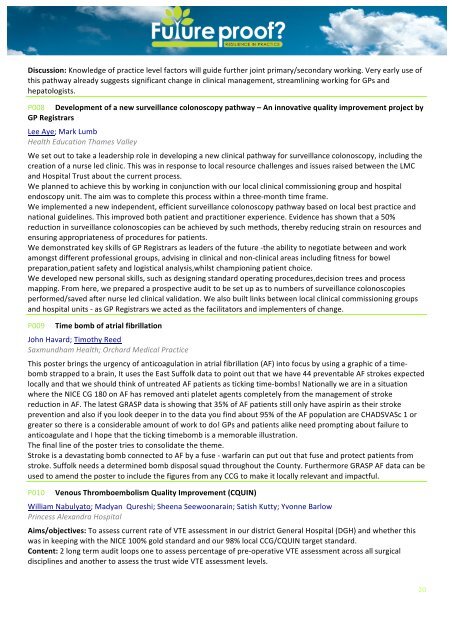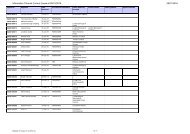RCGP-2014-poster-abstracts
RCGP-2014-poster-abstracts
RCGP-2014-poster-abstracts
Create successful ePaper yourself
Turn your PDF publications into a flip-book with our unique Google optimized e-Paper software.
Discussion: Knowledge of practice level factors will guide further joint primary/secondary working. Very early use of <br />
this pathway already suggests significant change in clinical management, streamlining working for GPs and <br />
hepatologists. <br />
P008 Development of a new surveillance colonoscopy pathway – An innovative quality improvement project by <br />
GP Registrars <br />
Lee Aye; Mark Lumb <br />
Health Education Thames Valley <br />
We set out to take a leadership role in developing a new clinical pathway for surveillance colonoscopy, including the <br />
creation of a nurse led clinic. This was in response to local resource challenges and issues raised between the LMC <br />
and Hospital Trust about the current process. <br />
We planned to achieve this by working in conjunction with our local clinical commissioning group and hospital <br />
endoscopy unit. The aim was to complete this process within a three-‐month time frame. <br />
We implemented a new independent, efficient surveillance colonoscopy pathway based on local best practice and <br />
national guidelines. This improved both patient and practitioner experience. Evidence has shown that a 50% <br />
reduction in surveillance colonoscopies can be achieved by such methods, thereby reducing strain on resources and <br />
ensuring appropriateness of procedures for patients. <br />
We demonstrated key skills of GP Registrars as leaders of the future -‐the ability to negotiate between and work <br />
amongst different professional groups, advising in clinical and non-‐clinical areas including fitness for bowel <br />
preparation,patient safety and logistical analysis,whilst championing patient choice. <br />
We developed new personal skills, such as designing standard operating procedures,decision trees and process <br />
mapping. From here, we prepared a prospective audit to be set up as to numbers of surveillance colonoscopies <br />
performed/saved after nurse led clinical validation. We also built links between local clinical commissioning groups <br />
and hospital units -‐ as GP Registrars we acted as the facilitators and implementers of change. <br />
P009 <br />
Time bomb of atrial fibrillation <br />
John Havard; Timothy Reed <br />
Saxmundham Health; Orchard Medical Practice <br />
This <strong>poster</strong> brings the urgency of anticoagulation in atrial fibrillation (AF) into focus by using a graphic of a time-bomb<br />
strapped to a brain, It uses the East Suffolk data to point out that we have 44 preventable AF strokes expected <br />
locally and that we should think of untreated AF patients as ticking time-‐bombs! Nationally we are in a situation <br />
where the NICE CG 180 on AF has removed anti platelet agents completely from the management of stroke <br />
reduction in AF. The latest GRASP data is showing that 35% of AF patients still only have aspirin as their stroke <br />
prevention and also if you look deeper in to the data you find about 95% of the AF population are CHADSVASc 1 or <br />
greater so there is a considerable amount of work to do! GPs and patients alike need prompting about failure to <br />
anticoagulate and I hope that the ticking timebomb is a memorable illustration. <br />
The final line of the <strong>poster</strong> tries to consolidate the theme. <br />
Stroke is a devastating bomb connected to AF by a fuse -‐ warfarin can put out that fuse and protect patients from <br />
stroke. Suffolk needs a determined bomb disposal squad throughout the County. Furthermore GRASP AF data can be <br />
used to amend the <strong>poster</strong> to include the figures from any CCG to make it locally relevant and impactful. <br />
P010 <br />
Venous Thromboembolism Quality Improvement (CQUIN) <br />
William Nabulyato; Madyan Qureshi; Sheena Seewoonarain; Satish Kutty; Yvonne Barlow <br />
Princess Alexandra Hospital <br />
Aims/objectives: To assess current rate of VTE assessment in our district General Hospital (DGH) and whether this <br />
was in keeping with the NICE 100% gold standard and our 98% local CCG/CQUIN target standard. <br />
Content: 2 long term audit loops one to assess percentage of pre-‐operative VTE assessment across all surgical <br />
disciplines and another to assess the trust wide VTE assessment levels. <br />
20



